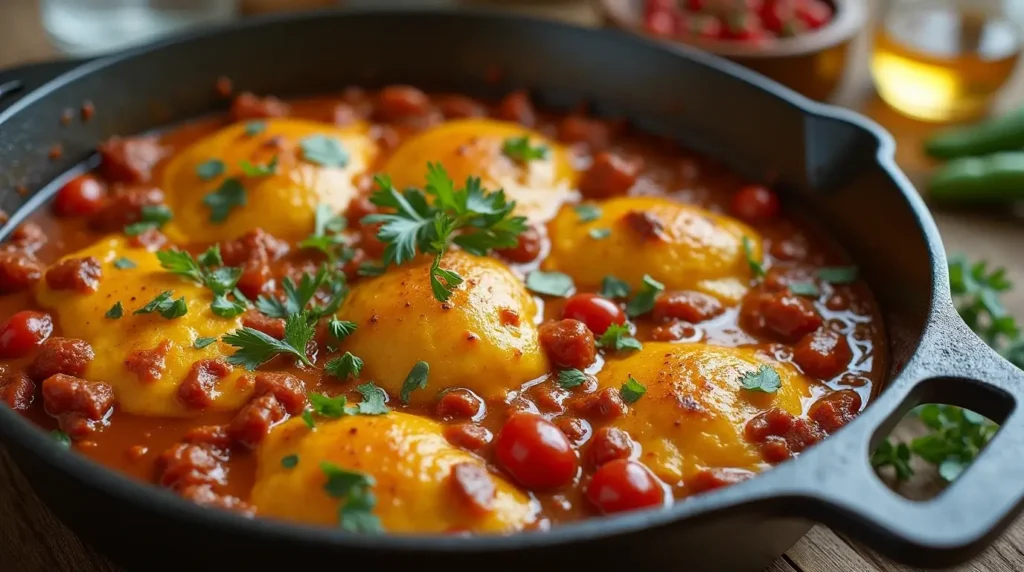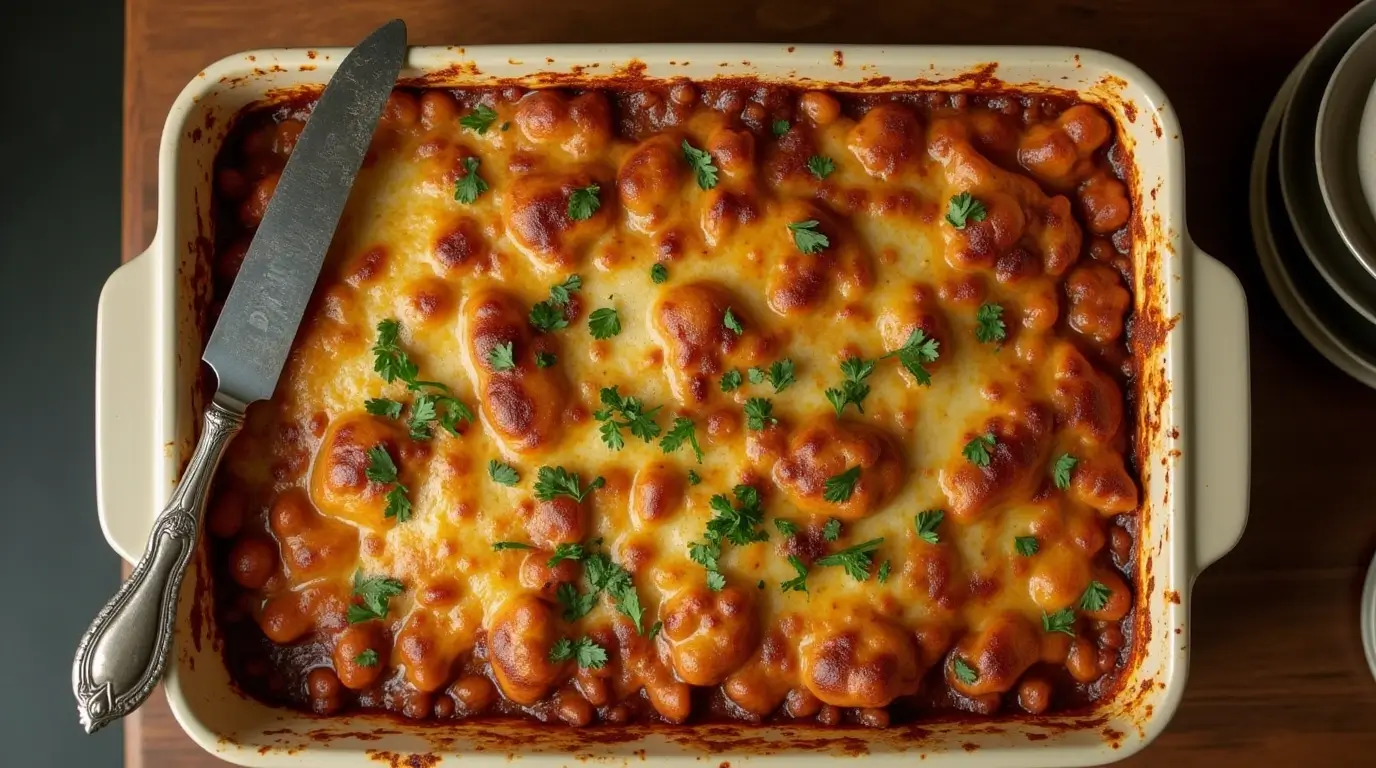Discover the rich flavors of a cattle drive casserole, perfect for a filling and satisfying meal. This guide has everything you need.
The cattle drive casserole is a hearty, comforting dish steeped in history. Its origins trace back to the meals prepared during the great cattle drives of the American West. This article explores the recipe and the history behind it. Moreover, you’ll learn all the tips for making it perfectly. Finally, you’ll understand why this dish remains a popular choice.
The History and Inspiration Behind Cattle Drive Casserole
A Taste of the Old West
Firstly, cattle drive casserole recipes were inspired by the meals cowboys ate on cattle drives. These drives were long and arduous journeys. Therefore, food needed to be portable, filling, and easy to prepare. The original recipes used simple, readily available ingredients.
The Need for Simple, Filling Meals
Secondly, the cooks needed to feed large crews with minimal resources. Thus, they relied on ingredients that could be stored and transported easily. Furthermore, simple, one-pot meals were favored. This helped ensure everyone was well-fed. Moreover, this practicality is what makes the casserole so appealing even today.
How It Evolved Into a Modern Classic
Thirdly, cattle drive casserole has evolved. It has adapted to modern kitchens and preferences. Consequently, updated recipes often include more varied ingredients and seasonings. Moreover, the core concept of a hearty, all-in-one meal remains. Therefore, it continues to be a staple in many households.
PrintHearty Cattle Drive Casserole: A Tasty Delight
- Total Time: 50 minutes
- Yield: 6 servings 1x
Description
Cattle drive casserole is a hearty, Tex-Mex inspired dish layered with ground beef, beans, cheese, and a creamy biscuit topping—perfect for feeding a hungry crowd or satisfying weeknight comfort food cravings.
Ingredients
1 pound ground beef
1 small onion, diced
1 (15 oz) can pinto or kidney beans, drained and rinsed
1 (10 oz) can diced tomatoes with green chilies (like Rotel)
1/2 teaspoon garlic powder
1/2 teaspoon chili powder
1/2 teaspoon cumin
Salt and pepper to taste
1 cup sour cream
1/2 cup mayonnaise
1 cup shredded cheddar cheese, divided
1 (8 oz) can refrigerated crescent roll dough
Instructions
1. Preheat oven to 350°F (175°C). Grease a 9×13-inch baking dish.
2. In a skillet over medium heat, cook ground beef and onion until beef is browned and onion is soft. Drain excess fat.
3. Stir in beans, diced tomatoes with chilies, garlic powder, chili powder, cumin, salt, and pepper. Simmer for 5 minutes.
4. Unroll crescent dough and press into the bottom of the baking dish to form a crust.
5. Spread beef mixture evenly over the dough.
6. In a bowl, mix sour cream, mayonnaise, and 1/2 cup shredded cheese. Spread over beef mixture.
7. Sprinkle remaining cheese on top.
8. Bake uncovered for 30–35 minutes until bubbly and golden.
9. Let rest for 5–10 minutes before serving.
Notes
Customize with jalapeños, black olives, or corn for extra flavor.
Use ground turkey or meatless crumbles for a lighter version.
Leftovers reheat well and make a great lunch the next day.
- Prep Time: 15 minutes
- Cook Time: 35 minutes
- Category: Main Course
- Method: Baking
- Cuisine: Tex-Mex
Nutrition
- Serving Size: 1 generous slice
- Calories: 490
- Sugar: 5g
- Sodium: 780mg
- Fat: 33g
- Saturated Fat: 14g
- Unsaturated Fat: 16g
- Trans Fat: 0g
- Carbohydrates: 25g
- Fiber: 4g
- Protein: 22g
- Cholesterol: 80mg
Keywords: cattle drive casserole, ground beef casserole, Tex-Mex bake, easy family dinner
Core Ingredients for an Authentic Cattle Drive Casserole
The Meat
- Ground Beef: This is the most common choice for the meat component. Ground beef adds rich flavor and substance.
- Other Meats: Ground sausage or a mix of beef and sausage can also be used. This creates a different flavor profile.
- Pre-cooked Meats: Leftover cooked meats like roast beef can be a great addition. This provides a variety of meat options.
The Vegetables
- Onions: Chopped onions provide flavor and a bit of sweetness.
- Bell Peppers: These add color and a slightly sweet taste. Green, red, or yellow peppers work well.
- Canned Tomatoes: Diced or crushed tomatoes form the base for the sauce.
- Corn: Canned or frozen corn adds texture and a touch of sweetness.
- Beans: Kidney beans or pinto beans are commonly used. These add fiber and heartiness to the dish.
The Starches and Binding Agents
- Potatoes: Sliced or diced potatoes provide bulk and absorb flavors.
- Pasta: Elbow macaroni or other small pasta shapes are often included.
- Rice: Cooked rice can also be a good choice for the carbohydrate base.
- Cheese: Shredded cheddar or a blend of cheeses are used as a topping and binder.
- Cream of Soup: Condensed cream of mushroom or chicken soup adds moisture and creates a creamy texture.
- Broth or Milk: Adds moisture and helps the casserole to bake evenly.
Seasonings and Spices
- Salt and Pepper: Essential seasonings for any savory dish.
- Garlic Powder: Adds a savory, aromatic flavor.
- Chili Powder: Provides a warm, spicy flavor.
- Cumin: Adds an earthy, slightly citrusy note.
- Onion Powder: Enhances the savory flavor.
- Worcestershire Sauce: This adds a depth of umami flavor.
Step-by-Step Guide: Preparing Your Own Cattle Drive Casserole

Prepping Your Ingredients
First, start by preheating your oven to 375°F (190°C). Then, grease a 9×13-inch baking dish. Make sure all your ingredients are chopped and measured beforehand. For example, brown the ground beef and chop all your veggies.
Building the Casserole
Next, in a large skillet, brown the ground beef. Drain off any excess grease. Add the onions and peppers. Sauté them until they’re soft. Then, add garlic and seasonings, cooking for about a minute. Add the diced tomatoes and beans. Stir in the cream of soup and a bit of broth or milk to make the mixture creamy. Lastly, add the potatoes, corn, and pasta or rice.
Combining and Baking
Afterward, pour the mixture into the prepared baking dish. Spread it evenly. Top with the shredded cheese. Bake for 25-30 minutes, or until the casserole is bubbly. The cheese on top should be golden brown. Let it cool for a few minutes before serving.
Serving Your Cattle Drive Casserole
Finally, let your cattle drive casserole cool slightly before serving. The flavors will meld beautifully after a little rest. Serve it warm as a complete meal. This dish goes well on its own or with simple side dishes. This will make a great family dinner.
Tips for the Best Cattle Drive Casserole
Achieving the Right Consistency
Firstly, ensure you don’t overcook the pasta or rice. They should be slightly undercooked, as they will continue to cook in the oven. The casserole should be moist, not soupy. Therefore, add broth or milk gradually.
Enhancing the Flavor
Secondly, sautéing the vegetables before adding them deepens their flavor. Also, using a mix of different spices will add depth. You can also add a pinch of red pepper flakes for a bit of heat. Finally, taste and adjust seasonings to your preference.
Substituting Ingredients
Thirdly, you can substitute ground beef with ground turkey or chicken for a leaner option. You can also use different types of beans or vegetables. Therefore, feel free to adjust ingredients based on your preferences.
Presentation and Serving Suggestions
Lastly, garnish with fresh parsley or a sprinkle of extra cheese before serving. Serve this casserole while it is warm to fully enjoy its comforting nature. Moreover, it pairs well with a simple salad or some cornbread. Therefore, consider all the possibilities of serving.
Creative Variations on Cattle Drive Casserole
Spicy Cattle Drive Casserole
To create a spicy cattle drive casserole, add some diced jalapeños. Additionally, you can add a dash of hot sauce or cayenne pepper to the mixture. Furthermore, using spicy sausage can increase the heat. Consequently, adjust the spice levels based on your preference.
Cheesy Cattle Drive Casserole
For a cheesy cattle drive casserole, mix different cheeses. For example, cheddar, Monterey Jack, and Colby are all excellent choices. Furthermore, you can add cream cheese for an extra creamy texture. Moreover, don’t forget the cheese topping to get a good result.
Veggie-Packed Cattle Drive Casserole
To make a veggie-packed cattle drive casserole, add more vegetables. You can include zucchini, carrots, or spinach for an extra boost of nutrition. Also, adding mushrooms will deepen the flavor. This option is loaded with nutrients and fiber.
Southwestern Cattle Drive Casserole
For a Southwestern twist, use chili seasoning. Add some green chilies, black beans, and a bit of cumin. Also, include a salsa to the mix for a richer flavor. Top with a blend of Monterey Jack and cheddar cheese. Consequently, this variation brings a unique flavor profile to the table.
Gluten-Free Cattle Drive Casserole
For a gluten-free cattle drive casserole, use gluten-free pasta or rice. Also, ensure the cream of soup is gluten-free. Moreover, use gluten-free breadcrumbs or crushed gluten-free crackers for topping if desired. Finally, always double-check the ingredient labels to ensure compliance.
Serving Suggestions and Pairings for Cattle Drive Casserole

Side Dishes
- Cornbread: A classic Southern side that complements the hearty casserole.
- Coleslaw: A cool and crisp coleslaw provides a refreshing contrast.
- Green Salad: A simple green salad with a light vinaigrette balances the meal.
- Garlic Bread: Toasted garlic bread is a great addition for dipping into the sauce.
- Baked Beans: A side of baked beans can enhance the flavors of the dish.
Main Course Pairings
- BBQ Ribs: For a heartier meal, serve alongside BBQ ribs.
- Grilled Chicken: Grilled chicken breasts are a good, lighter choice.
- Pulled Pork: Slow-cooked pulled pork is a delicious pairing.
- Vegetarian Options: Offer a lentil loaf or a hearty bean chili for vegetarians.
- Soup: Offer a cup of soup as an appetizer to create a more complete meal.
Drink Pairings
- Iced Tea: A classic choice for a casual meal.
- Lemonade: Refreshing lemonade is a good option.
- Light Beer: A light beer can complement the dish without overpowering it.
- Red Wine: A light-bodied red wine, such as Pinot Noir, pairs well.
- Sparkling Water: A refreshing, non-alcoholic choice for any occasion.
Storing and Reheating Your Cattle Drive Casserole
Storing Leftovers
First, let your cattle drive casserole cool completely. Then, transfer it to an airtight container. Store it in the refrigerator. It will keep fresh for about three to four days. Storing it properly is crucial for keeping it safe.
Reheating Methods
- Oven: Reheat in the oven at 350°F (175°C) until heated through. Cover with foil to prevent drying out. This is a great way to reheat evenly.
- Microwave: Reheat individual portions in the microwave. Heat in 30-second intervals until hot. Stir well between each interval.
- Skillet: Reheat individual portions in a skillet over medium heat. Add a bit of water or broth. Stir to prevent burning. This can create a nice crispy bottom.
- Air Fryer: Air fry at 325F for about 5-7 minutes until heated thoroughly. This is great for making a crispy topping.
- Slow Cooker: If you have a large amount of leftovers, you can heat in the slow cooker on low for 2-3 hours.
Freezing Your Casserole
To freeze the cattle drive casserole, cool it completely. Then wrap it tightly in plastic wrap or store it in a freezer-safe container. You can freeze it for up to three months. Defrost in the refrigerator overnight before reheating.
Tips for Reheating
For best results, add a little water or broth when reheating. This will help to prevent drying. Also, covering the dish while reheating helps to keep it moist. Finally, heat thoroughly to ensure safety.
Common Mistakes to Avoid When Making Cattle Drive Casserole
Overcooking the Pasta or Rice
Firstly, avoid overcooking the pasta or rice. They should be slightly undercooked. This will prevent them from becoming mushy. They will finish cooking in the oven.
Using Too Much Liquid
Secondly, be careful not to add too much liquid. The casserole should be moist, not soupy. Add broth or milk gradually. The texture should be creamy, not runny.
Under Seasoning the Dish
Thirdly, make sure to season the casserole generously. This is before you bake it. Taste and adjust the seasonings to your liking. Don’t be afraid to make bold adjustments.
Overbaking the Casserole
Fourthly, avoid overbaking the casserole. It should be bubbly and golden brown. Overbaking can make it dry. Watch it carefully while it’s cooking.
Forgetting to Grease the Dish
Fifthly, ensure to grease your baking dish properly. This prevents the casserole from sticking. You won’t get frustrated when trying to remove it.
Using Wrong Size Dish
Sixthly, you will need a dish that will fit all the ingredients without overflowing. This will ensure that the casserole is baked evenly and properly. Make sure the dish is big enough.
FAQs About Cattle Drive Casserole
Why is it called a John Wayne casserole?
The name “John Wayne casserole” is a common nickname for cattle drive casserole. It’s thought to be because of John Wayne’s image as a rugged cowboy, who embodies the spirit of the Old West. The hearty, simple nature of the dish makes it seem like something he would enjoy on the trail. It is the same basic recipe but goes by many different names.
What did they eat on cattle drives?
On cattle drives, cowboys ate simple, filling meals. These typically included beef, beans, biscuits, and coffee. They were often prepared over an open fire. Therefore, practicality and portability were important. Moreover, they relied on foods that wouldn’t spoil easily.
How many cows are in a cattle drive?
The number of cows in a cattle drive varied. They could be anywhere from a few hundred to several thousand. The size of the drive depended on the ranch and the distance. It also depended on the market they were headed to. The drives were very long and hard work.
What are the 5 components of a casserole?
The five main components of a casserole include a starch, a protein, vegetables, a binder, and a topping. The starch can be pasta, rice, or potatoes. The protein is often meat but can also be beans or legumes. The vegetables add nutrients and flavor. The binder can be a cream of soup, cheese, or broth. Finally, the topping often includes cheese or breadcrumbs.
Conclusion
In conclusion, the cattle drive casserole is a hearty and satisfying dish with a rich history. This guide provides all you need to make this delicious meal. Its combination of simple ingredients and robust flavors makes it perfect for any occasion. Furthermore, the versatility of this recipe allows you to easily adapt it to your own taste preferences. Whether you’re cooking for a family dinner or a gathering of friends, this casserole is sure to please. Therefore, enjoy making and sharing this classic, flavorful cattle drive casserole.
Don’t miss our Cottage Cheese Protein Brownies – The Ultimate Guide to Healthier Baking for another delicious take on brownies that might just steal the show!

